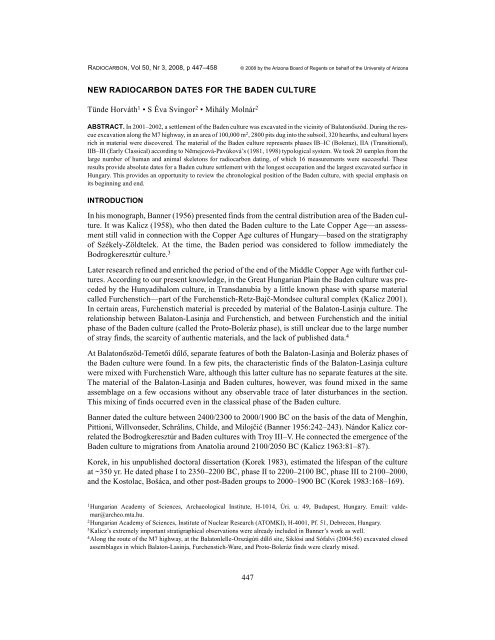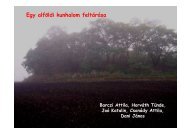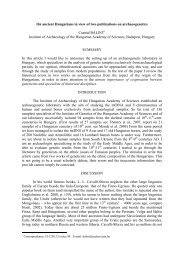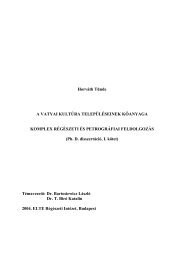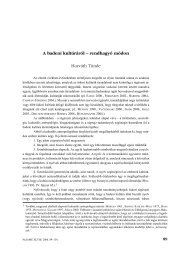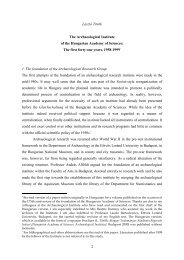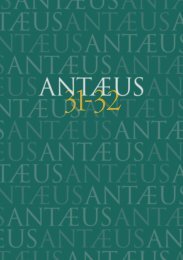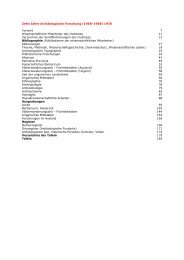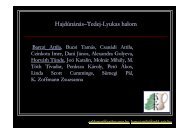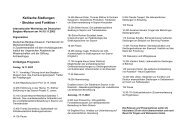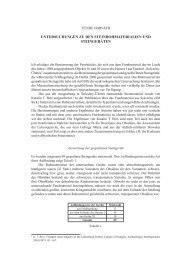new radiocarbon dates for the baden culture - Journals at the ...
new radiocarbon dates for the baden culture - Journals at the ...
new radiocarbon dates for the baden culture - Journals at the ...
- No tags were found...
You also want an ePaper? Increase the reach of your titles
YUMPU automatically turns print PDFs into web optimized ePapers that Google loves.
RADIOCARBON, Vol 50, Nr 3, 2008, p 447–458 © 2008 by <strong>the</strong> Arizona Board of Regents on behalf of <strong>the</strong> University of ArizonaNEW RADIOCARBON DATES FOR THE BADEN CULTURETünde Horváth 1 • S Éva Svingor 2 • Mihály Molnár 2ABSTRACT. In 2001–2002, a settlement of <strong>the</strong> Baden <strong>culture</strong> was excav<strong>at</strong>ed in <strong>the</strong> vicinity of Bal<strong>at</strong>onıszöd. During <strong>the</strong> rescueexcav<strong>at</strong>ion along <strong>the</strong> M7 highway, in an area of 100,000 m 2 , 2800 pits dug into <strong>the</strong> subsoil, 320 hearths, and cultural layersrich in m<strong>at</strong>erial were discovered. The m<strong>at</strong>erial of <strong>the</strong> Baden <strong>culture</strong> represents phases IB–IC (Boleraz), IIA (Transitional),IIB–III (Early Classical) according to N¢emejcová-Pavúková’s (1981, 1998) typological system. We took 20 samples from <strong>the</strong>large number of human and animal skeletons <strong>for</strong> <strong>radiocarbon</strong> d<strong>at</strong>ing, of which 16 measurements were successful. Theseresults provide absolute <strong>d<strong>at</strong>es</strong> <strong>for</strong> a Baden <strong>culture</strong> settlement with <strong>the</strong> longest occup<strong>at</strong>ion and <strong>the</strong> largest excav<strong>at</strong>ed surface inHungary. This provides an opportunity to review <strong>the</strong> chronological position of <strong>the</strong> Baden <strong>culture</strong>, with special emphasis onits beginning and end.INTRODUCTIONIn his monograph, Banner (1956) presented finds from <strong>the</strong> central distribution area of <strong>the</strong> Baden <strong>culture</strong>.It was Kalicz (1958), who <strong>the</strong>n d<strong>at</strong>ed <strong>the</strong> Baden <strong>culture</strong> to <strong>the</strong> L<strong>at</strong>e Copper Age—an assessmentstill valid in connection with <strong>the</strong> Copper Age <strong>culture</strong>s of Hungary—based on <strong>the</strong> str<strong>at</strong>igraphyof Székely-Zöldtelek. At <strong>the</strong> time, <strong>the</strong> Baden period was considered to follow immedi<strong>at</strong>ely <strong>the</strong>Bodrogkeresztúr <strong>culture</strong>. 3L<strong>at</strong>er research refined and enriched <strong>the</strong> period of <strong>the</strong> end of <strong>the</strong> Middle Copper Age with fur<strong>the</strong>r <strong>culture</strong>s.According to our present knowledge, in <strong>the</strong> Gre<strong>at</strong> Hungarian Plain <strong>the</strong> Baden <strong>culture</strong> was precededby <strong>the</strong> Hunyadihalom <strong>culture</strong>, in Transdanubia by a little known phase with sparse m<strong>at</strong>erialcalled Furchenstich—part of <strong>the</strong> Furchenstich-Retz-BajË-Mondsee cultural complex (Kalicz 2001).In certain areas, Furchenstich m<strong>at</strong>erial is preceded by m<strong>at</strong>erial of <strong>the</strong> Bal<strong>at</strong>on-Lasinja <strong>culture</strong>. Therel<strong>at</strong>ionship between Bal<strong>at</strong>on-Lasinja and Furchenstich, and between Furchenstich and <strong>the</strong> initialphase of <strong>the</strong> Baden <strong>culture</strong> (called <strong>the</strong> Proto-Boleráz phase), is still unclear due to <strong>the</strong> large numberof stray finds, <strong>the</strong> scarcity of au<strong>the</strong>ntic m<strong>at</strong>erials, and <strong>the</strong> lack of published d<strong>at</strong>a. 4At Bal<strong>at</strong>onıszöd-Temetıi d˚lı, separ<strong>at</strong>e fe<strong>at</strong>ures of both <strong>the</strong> Bal<strong>at</strong>on-Lasinja and Boleráz phases of<strong>the</strong> Baden <strong>culture</strong> were found. In a few pits, <strong>the</strong> characteristic finds of <strong>the</strong> Bal<strong>at</strong>on-Lasinja <strong>culture</strong>were mixed with Furchenstich Ware, although this l<strong>at</strong>ter <strong>culture</strong> has no separ<strong>at</strong>e fe<strong>at</strong>ures <strong>at</strong> <strong>the</strong> site.The m<strong>at</strong>erial of <strong>the</strong> Bal<strong>at</strong>on-Lasinja and Baden <strong>culture</strong>s, however, was found mixed in <strong>the</strong> sameassemblage on a few occasions without any observable trace of l<strong>at</strong>er disturbances in <strong>the</strong> section.This mixing of finds occurred even in <strong>the</strong> classical phase of <strong>the</strong> Baden <strong>culture</strong>.Banner d<strong>at</strong>ed <strong>the</strong> <strong>culture</strong> between 2400/2300 to 2000/1900 BC on <strong>the</strong> basis of <strong>the</strong> d<strong>at</strong>a of Menghin,Pittioni, Willvonseder, Schrálins, Childe, and MilojËiÊ (Banner 1956:242–243). Nándor Kalicz correl<strong>at</strong>ed<strong>the</strong> Bodrogkeresztúr and Baden <strong>culture</strong>s with Troy III–V. He connected <strong>the</strong> emergence of <strong>the</strong>Baden <strong>culture</strong> to migr<strong>at</strong>ions from An<strong>at</strong>olia around 2100/2050 BC (Kalicz 1963:81–87).Korek, in his unpublished doctoral dissert<strong>at</strong>ion (Korek 1983), estim<strong>at</strong>ed <strong>the</strong> lifespan of <strong>the</strong> <strong>culture</strong><strong>at</strong> ~350 yr. He d<strong>at</strong>ed phase I to 2350–2200 BC, phase II to 2200–2100 BC, phase III to 2100–2000,and <strong>the</strong> Kostolac, Bošáca, and o<strong>the</strong>r post-Baden groups to 2000–1900 BC (Korek 1983:168–169).1 Hungarian Academy of Sciences, Archaeological Institute, H-1014, Úri. u. 49, Budapest, Hungary. Email: valdemar@archeo.mta.hu.2Hungarian Academy of Sciences, Institute of Nuclear Research (ATOMKI), H-4001, Pf. 51, Debrecen, Hungary.3 Kalicz’s extremely important str<strong>at</strong>igraphical observ<strong>at</strong>ions were already included in Banner’s work as well.4 Along <strong>the</strong> route of <strong>the</strong> M7 highway, <strong>at</strong> <strong>the</strong> Bal<strong>at</strong>onlelle-Országúti d˚lı site, Siklósi and Sófalvi (2004:56) excav<strong>at</strong>ed closedassemblages in which Bal<strong>at</strong>on-Lasinja, Furchenstich-Ware, and Proto-Boleráz finds were clearly mixed.447
448 T Horváth et al.In <strong>the</strong> 1960s, <strong>new</strong> perspectives emerged regarding <strong>the</strong> d<strong>at</strong>ing of <strong>the</strong> Copper Age. The avalanche ofpublic<strong>at</strong>ions began with Renfrew’s (1969) study on <strong>the</strong> autonomous development of <strong>the</strong> Sou<strong>the</strong>astEuropean Copper Age. Neustupný’s (1968) paper had a similarly gre<strong>at</strong> significance. As <strong>the</strong> first toaccept <strong>the</strong> results of <strong>radiocarbon</strong> d<strong>at</strong>ing, Neustupný connected <strong>the</strong> Baden <strong>culture</strong> with <strong>the</strong> Aegean-An<strong>at</strong>olian circle through Poliochni: classical Baden = Poliochni II blue = pre-Troy I; l<strong>at</strong>er Baden/Kostolac = Poliochni III green = Troy I; in absolute <strong>d<strong>at</strong>es</strong>: 3600–2900 cal BC.N¢emejcová-Pavúková in her works on <strong>the</strong> ceramic typology of <strong>the</strong> Baden <strong>culture</strong> d<strong>at</strong>ed <strong>the</strong> <strong>culture</strong>mostly on <strong>the</strong> basis of uncalibr<strong>at</strong>ed 14 C <strong>d<strong>at</strong>es</strong> between 2800 and 2300/2200 BC (N¢emejcová-Pavúková1981). Near <strong>the</strong> end of her career, with <strong>the</strong> knowledge of calibr<strong>at</strong>ed <strong>d<strong>at</strong>es</strong>, she d<strong>at</strong>ed <strong>the</strong> Baden<strong>culture</strong> between 3690/3360 and 2910/2700 cal BC (N¢emejcová-Pavúková 1998:399).Based on <strong>the</strong> appearance of gynecomorphic vessels, Petrasch (1984) d<strong>at</strong>ed <strong>the</strong> beginning of <strong>the</strong> <strong>for</strong>m<strong>at</strong>ionof <strong>the</strong> Baden <strong>culture</strong> on Swiss lakeshore settlements to ~3850 cal BC. After evalu<strong>at</strong>ing all <strong>the</strong>available 14 C <strong>d<strong>at</strong>es</strong> <strong>for</strong> <strong>the</strong> period, Forenbaher (1993: Figure 4 on p 246) estim<strong>at</strong>ed <strong>the</strong> dur<strong>at</strong>ion of<strong>the</strong> Baden <strong>culture</strong> <strong>at</strong> ~800 yr, placing it between 3600 and 2800 cal BC.Un<strong>for</strong>tun<strong>at</strong>ely, most Hungarian scholars did not accept <strong>the</strong> results of 14 C d<strong>at</strong>ing until <strong>the</strong> 1980s and1990s. In Hungarian prehistoric research, it was Raczky who first used <strong>the</strong> so-called “long chronology,”as deline<strong>at</strong>ed by Renfrew and Neustupný, in connection with <strong>the</strong> Baden <strong>culture</strong> (Raczky 1995).Raczky d<strong>at</strong>ed <strong>the</strong> <strong>for</strong>m<strong>at</strong>ion of <strong>the</strong> Baden <strong>culture</strong> to ~3600 BC, synchronizing it with Kumtepe Ib,and its end around 3000 BC, which is contemporary with <strong>the</strong> beginning of Troy I and <strong>the</strong> Early HelladicI (Raczky 1995: Figure 1). Some scholars, however, have continued to support <strong>the</strong> short chronology(see e.g. Makkay 1996, 2003; Horváth 2001). In most Hungarian works on <strong>the</strong> Copper Age,however, <strong>the</strong> <strong>new</strong> chronology, and <strong>the</strong> resulting shift of more than 1000 yr back in time, is accepted.Synchroniz<strong>at</strong>ion with <strong>the</strong> various occup<strong>at</strong>ion layers <strong>at</strong> Troy has received <strong>new</strong> impetus with Korfmann’s<strong>new</strong> excav<strong>at</strong>ions <strong>at</strong> Troy, which <strong>for</strong> <strong>the</strong> first time provided 14 C <strong>d<strong>at</strong>es</strong> from <strong>the</strong> settlement(Korfmann and Kromer 1993). Based on <strong>the</strong>se <strong>new</strong> d<strong>at</strong>a, <strong>the</strong> beginning of <strong>the</strong> Baden <strong>culture</strong> can beplaced about 3700–3400 BC (“pre-Troy I” – Be∫ik-Yassitepe) and its end about 2920–2700 BC(Troy I early) (Korfmann and Kromer 1993:164–165). After collecting and evalu<strong>at</strong>ing 32 samplesfrom Baden <strong>culture</strong> sites, Stadler et al. (2001) d<strong>at</strong>ed <strong>the</strong> <strong>culture</strong> between 3640 and 2930 BC.From our point of view, <strong>the</strong> Boleráz m<strong>at</strong>erial from Arbon/Bleiche 3 on <strong>the</strong> shore of Lake Constancein Switzerland is of gre<strong>at</strong> importance and provides a secure point of departure. The life of <strong>the</strong> settlementcan be d<strong>at</strong>ed between 3385 and 3371 BC (de Capitani et al. 2002).NEW RESULTSBal<strong>at</strong>onıszöd-Temetıi d˚lıIn 2001 and 2002, during a 1-yr-long excav<strong>at</strong>ion campaign, we excav<strong>at</strong>ed a settlement of <strong>the</strong> Baden<strong>culture</strong> <strong>at</strong> Bal<strong>at</strong>onıszöd-Temetıi d˚lı. The area is loc<strong>at</strong>ed on <strong>the</strong> western bank of a tributary of LakeBal<strong>at</strong>on in a meridional valley stretching north-south along <strong>the</strong> river. The core of <strong>the</strong> early Bolerázphase settlement is in <strong>the</strong> north, th<strong>at</strong> of <strong>the</strong> transitional and classical Baden settlement is in <strong>the</strong> south.The survey and excav<strong>at</strong>ion of 3 pits with m<strong>at</strong>erial from <strong>the</strong> classical phase suggest th<strong>at</strong> on <strong>the</strong> easternbank of <strong>the</strong> riverbed (today a swamp), opposite <strong>the</strong> excav<strong>at</strong>ed area, a similar settlement was loc<strong>at</strong>edalong <strong>the</strong> river. These 2 parts probably belonged to a single settlement whose area exceeded200,000 m 2 (a size similar to th<strong>at</strong> of Ç<strong>at</strong>al Höyük) (Figure 1). In <strong>the</strong> nor<strong>the</strong>rn part of <strong>the</strong> Bolerázarea, close to <strong>the</strong> sou<strong>the</strong>rn shore of Lake Bal<strong>at</strong>on, <strong>the</strong> pits of <strong>the</strong> Boleráz phase were mixed with fe<strong>at</strong>uresof <strong>the</strong> Middle Copper Age Bal<strong>at</strong>on-Lasinja and Furchenstich <strong>culture</strong>s.
New 14 C D<strong>at</strong>es <strong>for</strong> <strong>the</strong> Baden Culture 449Figure 1 The Bal<strong>at</strong>onıszöd-Temetıi d˚lı site,<strong>the</strong> excav<strong>at</strong>ed area and its immedi<strong>at</strong>e vicinity(prepared by Zsolt Viemann, with <strong>the</strong> map basedon www.szekely.kiado.hu).The extent of <strong>the</strong> settlement of <strong>the</strong> Baden <strong>culture</strong> is identical to <strong>the</strong> boundaries of <strong>the</strong> excav<strong>at</strong>ed areain <strong>the</strong> east, north, and west; it exceeds it, however, in <strong>the</strong> south. It is possible th<strong>at</strong> in this unexcav<strong>at</strong>edarea <strong>the</strong> fe<strong>at</strong>ures of phase IV of <strong>the</strong> Baden <strong>culture</strong> could have been found. Un<strong>for</strong>tun<strong>at</strong>ely, this archaeologicallyintact area was destroyed during <strong>the</strong> construction of <strong>the</strong> highway (Horváth et al. 2007).D<strong>at</strong>a on <strong>the</strong> size of <strong>the</strong> settlement and <strong>the</strong> typological study of <strong>the</strong> m<strong>at</strong>erial suggest th<strong>at</strong> it is not only<strong>the</strong> largest settlement known so far, but also has <strong>the</strong> longest continuous occup<strong>at</strong>ion. The earliest, IAor Proto-Boleráz phase was not <strong>at</strong>tested <strong>at</strong> <strong>the</strong> site. The most characteristic archaeological fe<strong>at</strong>uresof <strong>the</strong> settlement are pits and hearths. The plans of 4 so-called Pfahlbau-type houses could be identified(Horváth et al. 2007). Besides <strong>the</strong> everyday refuse pits, <strong>the</strong> most interesting pits contained specialfinds (human mask, stamp seals, figurines, house models) and <strong>the</strong> remains of human and animalsacrifices (Horváth 2002a,b,c; 2004a,b).The number of human skeletons (usually interpreted as intramural burials) is almost 60. Some pitscontained 1 burial, o<strong>the</strong>rs 2, 3, or 4, and in 1 case even 5 burials (Horváth and Zoffmann 2004). Fe<strong>at</strong>ure1099 (Well 1) contained Bal<strong>at</strong>on-Lasinja sherds <strong>at</strong> <strong>the</strong> bottom and 10 human skeletons in <strong>the</strong>upper part of <strong>the</strong> fill, which, according to <strong>the</strong> 14 C <strong>d<strong>at</strong>es</strong>, were placed in <strong>the</strong> (probably cleaned andreused) well in <strong>the</strong> Boleráz phase of <strong>the</strong> Baden <strong>culture</strong> (Horváth et al. 2003). The multilayered sacrificialpits contained both human and animal skeletons. In about 50 pits, only animal remains werefound (Horváth 2006). Samples <strong>for</strong> 14 C d<strong>at</strong>ing were taken from <strong>the</strong> pits (Pits 203, 426, 1612), usuallyfrom human or animal bones, and in 1 case from charcoal (Table 1, Figure 2).Un<strong>for</strong>tun<strong>at</strong>ely, from <strong>the</strong> samples taken from <strong>the</strong> fill of Well 1, only <strong>the</strong> skeleton of Grave 70 from <strong>the</strong>uppermost layer of <strong>the</strong> fill yielded usable d<strong>at</strong>a. The sample taken from <strong>the</strong> skeleton of Grave 84 (<strong>the</strong>skeleton of a child) was unsuitable <strong>for</strong> d<strong>at</strong>ing; groundw<strong>at</strong>er probably dissolved <strong>the</strong> collagen from <strong>the</strong>bones needed <strong>for</strong> <strong>the</strong> measurement. Similarly, <strong>the</strong> sample from <strong>the</strong> lower layer of <strong>the</strong> fill of Pit 1612was contamin<strong>at</strong>ed and provided an unrealistic d<strong>at</strong>e; consequently, it cannot be used in interpreting<strong>the</strong> chronological rel<strong>at</strong>ionship between <strong>the</strong> lower and upper layers of <strong>the</strong> pit.
450 T Horváth et al.Table 1 Overview of samples and 14 C results.δ 13 C VPDB(‰)±0.2‰14 C age BP1 σ (68.3%)Calibr<strong>at</strong>ed d<strong>at</strong>e arange, cal BC1 σ (68.3%)Lab code Description of samplesDeb-13381 Pit 2689 (with gynecomorphic vessel). –19.3 4110 ± 50 2854–2803 (25%)Animal bone.2734–2591 (75%)Deb-13389 Grave 37, Pit 1489. Human bone. –19.2 4200 ± 35 2889–2856 (34%)2807–2751 (54%)2719–2702 (12%)Deb-13245 Grave 50, Pit 2019. Human bone. –19.7 4220 ± 50 2904–2851 (47%)2808–2720 (53%)Deb-13387 Multilayered sacrificial Pit 426: middlelayer. Charcoal.–24.5 4310 ± 50 3000–2969 (23%)2950–2888 (77%)Deb-13386 Pit 2596 (with figurine). Animal bone. –19.4 4330 ± 35 3007–2976 (31%)2944–2899 (69%)Deb-13382 Pits 1072–1096 (with human mask fragment).–20.2 4360 ± 45 3017–2913 (100%)Animal bone.Deb-13292 Multilayered sacrificial Pit 426: Grave –19.7 4380 ± 45 3072–2919 (100%)67, lowermost layer. Human bone.Deb-13374 Multilayered sacrificial Pit 1036: sheep –19.9 4390 ± 60 3091–2920 (100%)skeleton. Animal bone.Deb-13244 Multilayered sacrificial Pit 203: lowerlayer. Skull of bovine.–20.3 4440 ± 60 3321–3220 (38%)3126–2952 (62%)Deb-13412 Multilayered sacrificial Pit 1612: upperlayer. Dog skeleton.–19.9 4440 ± 70 3319–3214 (37%)3136–2985 (63%)Deb-13286 Pit 2635: Grave 79. Human bone. –19.7 4440 ± 45 3315–3225 (36%)3122–3000 (64%)Deb-13411 Pit 2060 (with house model). Animalbone.–19.5 4445 ± 45 3323–3222 (40%)3122–3012 (60%)Deb-13395 Pit 2614: Grave 74. Animal bone besidehuman skeleton.–20.3 4460 ± 50 3326–3216 (51%)3128–3028 (49%)Deb-13379 Pit 1099. Well 1: Grave 70, human (Boleraz)skeletons in <strong>the</strong> well of Bal<strong>at</strong>on-Lasinja <strong>culture</strong>.–20.6 4480 ± 70 3333–3090 (100%)Deb-13277 Multilayered sacrificial Pit 426: Grave23, upper layer.–19.9 4520 ± 60 3349–3286 (31%)3251–3113 (69%)Deb-13291 Pits 2327–2346. Animal bone. –20.4 4550 ± 80 3366–3111 (100%)Deb-13398 Pit 2581 (with stamp seal). Animal bone. –20.9 4680 ± 45 3519–3491 (30%)3469–3373 (70%)aCalibr<strong>at</strong>ed with CALIB 5.0.1 (Stuiver and Reimer 1993) based on IntCal04 calibr<strong>at</strong>ion curve (Reimer et al. 2004).14 C D<strong>at</strong>ingThe 14 C d<strong>at</strong>ing of 1 charcoal sample and 17 bone samples was per<strong>for</strong>med in <strong>the</strong> Hertelendi Labor<strong>at</strong>oryof Environmental Studies of ATOMKI. The samples were d<strong>at</strong>ed according to <strong>the</strong> standard labor<strong>at</strong>oryprocedures. The charcoal sample was first mechanically cleaned, <strong>the</strong>n tre<strong>at</strong>ed by <strong>the</strong> standardacid-base-acid (ABA) method. For bone measurements, after <strong>the</strong> mechanical cleaning weextracted collagen following <strong>the</strong> method introduced by Longin (1971). The dried samples werecombusted and <strong>the</strong> liber<strong>at</strong>ed CO 2 gas was purified over charcoal, <strong>the</strong>n cryogenically separ<strong>at</strong>ed fromo<strong>the</strong>r gases using liquid N 2 (Csongor et al. 1982), <strong>the</strong>n stored <strong>for</strong> about a month to allow <strong>the</strong> radonto decay. Sample 14 C activity was measured using <strong>the</strong> gas proportional counting method (Csongorand Hertelendi 1986; Hertelendi et al. 1989). The standard devi<strong>at</strong>ion applying this method <strong>for</strong> a singlemodern 14 C measurement was 0.5% (Hertelendi 1990). δ 13 C PDB (‰) values were measuredusing a ThermoFinnigan Delta PLUS XP mass spectrometer. Each sample is routinely measured twiceand <strong>the</strong> mean value is calcul<strong>at</strong>ed. The age is calcul<strong>at</strong>ed following <strong>the</strong> recommend<strong>at</strong>ions given by
New 14 C D<strong>at</strong>es <strong>for</strong> <strong>the</strong> Baden Culture 451Figure 2 Bal<strong>at</strong>onıszöd-Temetıi d˚lı. Plan of <strong>the</strong> excav<strong>at</strong>ion and fe<strong>at</strong>ures with samples <strong>for</strong>14C d<strong>at</strong>ing. Prepared by Zsolt Viemann.Stuiver and Polach (1977) and <strong>the</strong> fraction<strong>at</strong>ion correction <strong>for</strong> δ 13 C is applied. The conventional 14 Cage was calibr<strong>at</strong>ed with <strong>the</strong> CALIB 5.01 program (Stuiver and Reimer 1993) using <strong>the</strong> IntCal04 d<strong>at</strong>aset (Reimer et al. 2004). The quality system in <strong>the</strong> labor<strong>at</strong>ory has been improved and <strong>the</strong> ISO 9001:2000 standard has been implemented. Particip<strong>at</strong>ion in several 14 C intercomparison studies (TIRI,VIRI, FIRI) is part of <strong>the</strong> quality assurance program.14 C d<strong>at</strong>ing results of 17 samples from <strong>the</strong> Bal<strong>at</strong>onıszöd-Temetıi d˚lı settlement are shown inTable 1. Both <strong>the</strong> conventional 14 C age and calibr<strong>at</strong>ed age ranges (with 1-σ confidence intervals) aregiven. Probabilities of <strong>the</strong> calibr<strong>at</strong>ed age ranges are also given; probabilities
452 T Horváth et al.Timespan Lab code: 14 C age, BP Probability distributionsEarly Deb-13381: 4110 ± 50ClassicalDeb-13389: 4200 ± 35Baden,younger Deb-13245: 4220 ± 50sum Early Classical Baden younger (3 samples)Deb-13387: 4310 ± 50EarlyDeb-13386: 4330 ± 35ClassicalBaden,Deb-13382: 4360 ± 45older Deb-13292: 4380 ± 45Deb-13374: 4390 ± 60sum Early Classical Baden, older (5 samples)Deb-13244: 4440 ± 60Deb-13412: 4440 ± 70Deb-13286: 4440 ± 45Deb-13411: 4445 ± 45BolerazDeb-13395: 4460 ± 50Deb-13379: 4480 ± 70Deb-13277: 4520 ± 60Deb-13291: 4550 ± 80sum Boleraz (8 samples)Earliest Deb-13398: 4680 ± 45Boleraz IB3700Figure 3 Graphical present<strong>at</strong>ion of 14 C results3050calendar d<strong>at</strong>e, cal BC2400Calibr<strong>at</strong>ed d<strong>at</strong>e, cal BC1 σ (68.3%) ranges2854–2591 cal BC2889–2702 cal BC2904–2720 cal BC2892–2687 cal BC3000–2888 cal BC3007–2899 cal BC3017–2913 cal BC3072–2919 cal BC3091–2920 cal BC3016 –2900 cal BC3321–2952 cal BC3319–2985 cal BC3315–3000 cal BC3323–3012 cal BC3326–3028 cal BC3333–3090 cal BC3349–3113 cal BC3366–3111 cal BC3325–3027 cal BC3519–3373 cal BCDuring <strong>the</strong> archaeological analysis of <strong>the</strong> Baden m<strong>at</strong>erial from Bal<strong>at</strong>onıszöd-Temetıi d˚lı, <strong>the</strong>faults of N¢emejcová-Pavúková’s (1981, 1998) system became clear on a number of occasions. Thishas also been implied in o<strong>the</strong>r studies of <strong>the</strong> Baden <strong>culture</strong> (e.g. Bondár 2002).Consequently, in this paper we grouped <strong>the</strong> usable samples according to <strong>the</strong>ir 14 C age. Sum calibr<strong>at</strong>ionwas restricted to 2 phases (Boleráz and Early Classic), where 14 C ages with a 95% confidencelevel coincided. In this system, 2 samples were assigned to different groups than <strong>the</strong>ir archaeologicaltypological identific<strong>at</strong>ion (Deb-13386, Pit 2596: originally Early Baden; Deb-13412, Pit 1612: originallyphase IIB–III according to <strong>the</strong>ir finds). We decided to integr<strong>at</strong>e <strong>the</strong> ra<strong>the</strong>r controversial (andtypologically not clearly defined) transitional phase IIA into 2 basic groups according to <strong>the</strong> age of<strong>the</strong> samples. Thus, <strong>the</strong> Early Classic IIB–III group could be fur<strong>the</strong>r divided into an older and ayounger subgroup (see Figure 4).According to <strong>the</strong> correl<strong>at</strong>ion of <strong>the</strong> fine periodiz<strong>at</strong>ion based on typological study and <strong>the</strong> 14 C <strong>d<strong>at</strong>es</strong>,we can place <strong>the</strong> Boleráz IB–C phases to 3519/3373–3027 cal BC, and <strong>the</strong> Early Classical IIB–IIIphases to 3016–2687 cal BC (Figure 3; Table 2) <strong>at</strong> Bal<strong>at</strong>onıszöd. The 3800 cal BC d<strong>at</strong>e <strong>for</strong> <strong>the</strong>beginning of <strong>the</strong> Baden <strong>culture</strong> suggested by Petrasch(1984) thus seems a bit too early (<strong>for</strong> a critique,see PavelËík 1988).The absolute <strong>d<strong>at</strong>es</strong> of <strong>the</strong> <strong>for</strong>m<strong>at</strong>ive, Proto-Boleráz phase of <strong>the</strong> Baden <strong>culture</strong> do not seem to bemarkedly different from those of <strong>the</strong> Boleráz phase: »ervený Hrádok: 4820–4710 BP (3640–3520cal BC); Gyöngyöshalász: 4790 BP 5 (3640–3520 cal BC); Hlinsko: 4775–4670 BP (3630–3380 calBC).5 Szabó (1983: note 3): Charcoal sample, uncalibr<strong>at</strong>ed d<strong>at</strong>e! Based on <strong>the</strong> published m<strong>at</strong>erial, <strong>the</strong> settlement belongs to <strong>the</strong>Boleráz IB–C horizon ra<strong>the</strong>r than Proto-Boleráz IA.
New 14 C D<strong>at</strong>es <strong>for</strong> <strong>the</strong> Baden Culture 453Early Classical Badencal BC 3016 – 2900 (1σ)Earliest Bolerazcal BC 3519 - 3373 (1σ)Young ClassicalBadencal BC 2892 – 2687 (1σ)Bolerazcal BC 3325 – 3027 (1σ)(1σ)(1σ)(1σ)(1σ)38003600340032003000calendar d<strong>at</strong>e, cal BCFigure 4 Result of sum calibr<strong>at</strong>ion of 14 C ages of samples from individual groups of <strong>the</strong> Baden <strong>culture</strong>Table 2 List of 14 C <strong>d<strong>at</strong>es</strong> from <strong>the</strong> Baden <strong>culture</strong> sites in Hungary.Name of site Time periodNr ofsamples14 C d<strong>at</strong>e cal BC14C yrBP ReferencesGyöngyöshalász- IA Protoboleraz? 2 3650/3630 to 4790 Wild et al. 2001: Table 1Encspuszta3380/3370 ±50Kesz<strong>the</strong>ly- IA Protoboleraz 2 3720/3680 to — Kalicz 2001: 406.Fenékpuszta3690/3580Gyır-SzabadrétdombIB–C Boleraz 10 3508/3286 to — Figler et al. 1997: Table 23284/2924Szihalom IB–C Boleraz 8 3780/3630 to3380/36004850–4735Wild et al. 2001, Table 1;Stadler et al. 2001: Table 7Sümeg Classical 1 3350–3100 ±60 4520 Forenbaher 1993;Stadler et al. 2001: Table 7Vámosgyörk Classical 2 3330/3090 to 4475– Stadler et al. 2001: Table 73040/2920 4400Nagykanizsa Classical III–IV 5 3320/2870 to3030/2510 ±504455–4080Stadler et al. 2001: Table 7;Barna 2003Szigetcsép Post-Baden Kostolác1 3040–2910 ±45 4350 Forenbaher 1993;Stadler et al. 2001: Table 7According to Raetzel-Fabian and Furholt (2006), <strong>the</strong> earliest known 14 C <strong>d<strong>at</strong>es</strong> <strong>for</strong> <strong>the</strong> Baden <strong>culture</strong>from Grub an der March (3 samples, 4790–4760 BP [3630–3530 cal BC]), Schwech<strong>at</strong> (1 sample,4935 BP [3760–3660 cal BC]); Szihalom 6 (8 samples, 4850–4735 BP (3650–3520 cal BC]); andJeviöovice C2 (~3700 cal BC) should be handled with caution. Instead, a d<strong>at</strong>e of 3600/3500 cal BC<strong>for</strong> <strong>the</strong> beginning of <strong>the</strong> Baden <strong>culture</strong> (i.e. beginning of Boleraz IB) should be preferred. We wouldplace <strong>the</strong> <strong>for</strong>m<strong>at</strong>ive (Proto-Boleraz?) phase of <strong>the</strong> <strong>culture</strong> be<strong>for</strong>e 3600/3500 cal BC, which cannotyet be called <strong>the</strong> Baden <strong>culture</strong> proper (maybe <strong>the</strong> Schöninger group in Lower Saxony; Raetzel-Fabian and Furholt 2006).Based on <strong>the</strong> situ<strong>at</strong>ion in <strong>the</strong> L<strong>at</strong>e Copper and Early Bronze Age in Hungary, placing <strong>the</strong> end of <strong>the</strong>Baden <strong>culture</strong> around 3000 cal BC (Pétrequin et al. 2006: end of Kostolac <strong>culture</strong>) or 2930 cal BC(Stadler et al. 2001) seems too early. 7 This would leave a period of many centuries <strong>for</strong> <strong>the</strong> transi-2800260024006 According to <strong>the</strong> extremely short excav<strong>at</strong>ion report, Middle Copper Age graves of <strong>the</strong> Ludanice <strong>culture</strong> and L<strong>at</strong>e CopperAge Boleráz phase pits were excav<strong>at</strong>ed <strong>at</strong> <strong>the</strong> site. It is possible th<strong>at</strong> <strong>the</strong> samples were taken from fe<strong>at</strong>ures of <strong>the</strong> Ludanicegroup, and not <strong>the</strong> Boleráz phase, which is why <strong>the</strong>y are so early (Szabó 1997).
454 T Horváth et al.tional phase between <strong>the</strong> L<strong>at</strong>e Copper and Early Bronze Age (Kostolac and VuËedol <strong>culture</strong>s) and<strong>the</strong> first (Bell Beaker, Makó-Kosihy-»aka, Form<strong>at</strong>ive Nyírség, and L<strong>at</strong>e VuËedol <strong>culture</strong>s) and secondphases (Bell Beaker, Somogyvár-Vinkovci, L<strong>at</strong>e Makó, Nyírség, Proto-Nagyrév, and Pitvaros<strong>culture</strong>s) of <strong>the</strong> Early Bronze Age. This would result in a (not archaeologically supported) longlifespan of <strong>the</strong>se <strong>culture</strong>s or a longer hi<strong>at</strong>us without occup<strong>at</strong>ion, which is one of <strong>the</strong> main argumentsof those who still do not believe in <strong>the</strong> 14 C-based “long chronology” (e.g. Makkay 1996, 2003). Thisapparent contradiction, however, can be solved. In Hungary, <strong>the</strong> Classical phase of <strong>the</strong> Baden <strong>culture</strong>would begin <strong>at</strong> a time th<strong>at</strong> has been previously suggested as <strong>the</strong> d<strong>at</strong>e <strong>for</strong> <strong>the</strong> end of <strong>the</strong> <strong>culture</strong>by intern<strong>at</strong>ional research.Thus, <strong>the</strong> end of <strong>the</strong> Baden <strong>culture</strong> can be d<strong>at</strong>ed to 2800/2600 BC, con<strong>for</strong>ming with those opinionsth<strong>at</strong> d<strong>at</strong>e <strong>the</strong> beginning of <strong>the</strong> Bronze Age (Bz A1) around 2300 BC (which is parallel to phase 3 of<strong>the</strong> Early Bronze Age in Hungary; Reményi 2003). 8DISCUSSIONBased on <strong>the</strong> liter<strong>at</strong>ure on <strong>the</strong> Baden <strong>culture</strong> (mainly focusing on ceramic typology and 14 C <strong>d<strong>at</strong>es</strong>),<strong>the</strong> following st<strong>at</strong>ements can be <strong>for</strong>mul<strong>at</strong>ed regarding <strong>the</strong> absolute and rel<strong>at</strong>ive chronology of <strong>the</strong><strong>culture</strong>:1. One of <strong>the</strong> most problem<strong>at</strong>ic phases is <strong>the</strong> first, <strong>for</strong>m<strong>at</strong>ive phase of <strong>the</strong> <strong>culture</strong>. At present, <strong>the</strong>Proto-Boleráz and Boleráz phases cannot be distinguished from each o<strong>the</strong>r on <strong>the</strong> basis of 14 C<strong>d<strong>at</strong>es</strong>, as opposed to <strong>the</strong> Boleráz and Classical phases.The same tendency can be observed in archaeological typology as well: Proto-Boleráz m<strong>at</strong>erialis not everywhere <strong>at</strong>tested in <strong>the</strong> distribution area of <strong>the</strong> l<strong>at</strong>er Boleráz phase. It is thus questionableto wh<strong>at</strong> extent <strong>the</strong> Proto-Boleráz phase can be regarded as a predecessor of <strong>the</strong> Bolerázphase. Is it possible th<strong>at</strong> it could have emerged in o<strong>the</strong>r areas as well? The exact distribution of<strong>the</strong> Proto-Boleráz phase in Hungary also needs fur<strong>the</strong>r investig<strong>at</strong>ion, as does <strong>the</strong> description ofits m<strong>at</strong>erial from au<strong>the</strong>ntically excav<strong>at</strong>ed sites.2. The l<strong>at</strong>est works examining <strong>the</strong> Baden <strong>culture</strong> (Stadler et al. 2001; Wild et al. 2001) point outth<strong>at</strong> <strong>the</strong> Cernavod„ I <strong>culture</strong> is already contemporaneous with <strong>the</strong> Baden <strong>culture</strong> according to<strong>the</strong> 14 C <strong>d<strong>at</strong>es</strong>; consequently, <strong>the</strong> Cernavod„ III <strong>culture</strong> cannot be contemporaneous with <strong>the</strong> Bolerázphase. It can only be l<strong>at</strong>er. Thus, <strong>the</strong>se <strong>culture</strong>s must be re-examined with <strong>the</strong> help of traditionalarchaeological typological methods as well, and <strong>new</strong> calibr<strong>at</strong>ed 14 C <strong>d<strong>at</strong>es</strong> must be comparedto <strong>the</strong> whole Cernavod„ I–III–II developmental sequence.In <strong>the</strong> sou<strong>the</strong>rn distribution area of <strong>the</strong> Baden <strong>culture</strong>, Ezero XIII–VII and Sitagroi IV arealready contemporaneous with <strong>the</strong> classical Baden. All this suggests th<strong>at</strong> <strong>the</strong> Baden <strong>culture</strong>emerged in central Europe (Lower Austria, Burgenland, Moravia, Slovakia, and western Hungary)and spread towards sou<strong>the</strong>astern Europe (Stadler et al. 2001; Wild et al. 2001). At <strong>the</strong>same time, <strong>the</strong> west-east spread suggested by Maran (1998) is possible as well.7 At Bal<strong>at</strong>onıszöd-Temetıi d˚lı, <strong>the</strong> end of <strong>the</strong> Baden settlement is d<strong>at</strong>ed by samples Deb-13245, -13389, and -13381 (2892–2687 cal BC). Presently, <strong>the</strong> only Baden site in Hungary th<strong>at</strong> reaches <strong>the</strong> final phase IV of <strong>the</strong> Baden <strong>culture</strong>, which has beend<strong>at</strong>ed with 14 C, is Nagykanizsa-Billa (phase III–IV according to N¢emejcová-Pavúková’s system: see Barna 2003). Its l<strong>at</strong>estd<strong>at</strong>e is 4080 ± 40 BP (2840–2570 cal BC) (Stadler et al 2001: Table 7).8This way, however, it is conceivable th<strong>at</strong> <strong>the</strong> beginning of <strong>the</strong> Early Bronze Age, especially <strong>the</strong> 14 C <strong>d<strong>at</strong>es</strong> of <strong>the</strong> Bell Beaker-Csepel group, will overlap with <strong>the</strong> end of <strong>the</strong> Baden <strong>culture</strong> (see Raczky et al. 1994:42–43). It is now impossible to realisticallyassess <strong>the</strong> relevance of <strong>the</strong> 14 C <strong>d<strong>at</strong>es</strong> from samples collected by H Quitta and evalu<strong>at</strong>ed in <strong>the</strong> Berlin labor<strong>at</strong>ory. The<strong>d<strong>at</strong>es</strong> are given in conventional BP and calibr<strong>at</strong>ed BC <strong>for</strong>m, without giving <strong>the</strong> sigma values.
New 14 C D<strong>at</strong>es <strong>for</strong> <strong>the</strong> Baden Culture 455Based on <strong>the</strong> <strong>new</strong> d<strong>at</strong>a from Bal<strong>at</strong>onıszöd-Temetıi d˚lı, we may add <strong>the</strong> following to <strong>the</strong> abovest<strong>at</strong>ements:1. According to <strong>the</strong> 14 C <strong>d<strong>at</strong>es</strong>, <strong>the</strong> fe<strong>at</strong>ures of <strong>the</strong> Boleráz phase <strong>at</strong> Bal<strong>at</strong>onıszöd-Temetıi d˚lı arecontemporaneous with <strong>the</strong> settlement of Arbon/Bleiche 3. O<strong>the</strong>r sites in Hungary, assignedwith certainty to <strong>the</strong> Boleráz phase, have yielded similar <strong>d<strong>at</strong>es</strong> (Table 3: Gyır-Szabadrétdomb).On <strong>the</strong> basis of archaeological typology, o<strong>the</strong>r Hungarian sites (Szihalom-Sóhajtó,Gyöngyö-shalász-Encspuszta: Szabó 1983) are problem<strong>at</strong>ic, and, un<strong>for</strong>tun<strong>at</strong>ely, unpublished.We may thus conclude th<strong>at</strong> <strong>the</strong> fully developed Boleráz m<strong>at</strong>erial <strong>culture</strong> appeared <strong>at</strong> <strong>the</strong> sametime in western Europe (Switzerland) and east-central Europe (Hungary). Thus, <strong>the</strong> west-eastspread suggested by Maran (1998) seems unlikely. A north-south spread, however, seemsequally unlikely, <strong>at</strong> least it cannot be demonstr<strong>at</strong>ed on such a sp<strong>at</strong>ial scale.2. We have to take into account th<strong>at</strong> <strong>the</strong> technological innov<strong>at</strong>ions of <strong>the</strong> L<strong>at</strong>e Copper Age (woollysheep – weaving and spinning, <strong>new</strong> raw m<strong>at</strong>erials <strong>for</strong> clothing and <strong>new</strong> costumes; <strong>the</strong> so-calledSecondary Products Revolution in agri<strong>culture</strong>, alcoholic beverages, and <strong>the</strong> vessels used <strong>for</strong><strong>the</strong>ir consumption) and <strong>the</strong> invention of <strong>the</strong> wheel (toge<strong>the</strong>r with <strong>the</strong> wagon and <strong>the</strong> whole tractioncomplex) spread so rapidly in <strong>the</strong> European continent along <strong>the</strong> larger rivers (especially <strong>the</strong>Danube) th<strong>at</strong> this process cannot be demonstr<strong>at</strong>ed <strong>at</strong> <strong>the</strong> current level of accuracy of 14 C <strong>d<strong>at</strong>es</strong>.We also have to take into account <strong>the</strong> possibility th<strong>at</strong> <strong>the</strong> inventions of this technological revolutionspread from 2 directions <strong>at</strong> <strong>the</strong> same time: from western and east-central Europe(Köninger et al. 2001) and An<strong>at</strong>olia through sou<strong>the</strong>ast Europe (Uruk expansion: Sherr<strong>at</strong>t 2003),and met somewhere in <strong>the</strong> Carp<strong>at</strong>hian Basin.It is conceivable th<strong>at</strong> <strong>the</strong> speed of <strong>the</strong> dispersion of <strong>the</strong>se innov<strong>at</strong>ions was so high th<strong>at</strong> hundredsof km were covered within a decade or less (<strong>the</strong> distance between Lake Constance and LakeBal<strong>at</strong>on along <strong>the</strong> Danube is ~750 km), and 14 C is not yet suitable <strong>for</strong> <strong>the</strong> detection of such shortperiods. It is a question whe<strong>the</strong>r <strong>the</strong>re is actually an archaeological or scientific method th<strong>at</strong> iscapable of such a resolution (except <strong>for</strong> dendrochronology, which is, however, useless in <strong>the</strong>Carp<strong>at</strong>hian Basin due to <strong>the</strong> lack of arboreal remains).3. The direction of <strong>the</strong> so-called “Badeniz<strong>at</strong>ion” process (which, in our opinion, means <strong>the</strong> spreadof Boleráz/Cernavod„ III-type m<strong>at</strong>erial) can be examined only with traditional archaeologicalmethods <strong>at</strong> <strong>the</strong> present. For this, however, we need a distribution map th<strong>at</strong> would present <strong>the</strong>sites of <strong>the</strong> Baden <strong>culture</strong> in Europe <strong>at</strong> least in 2 stages (early or Boleráz phase and l<strong>at</strong>e or ClassicalBaden phase).Such a distribution map was prepared on <strong>the</strong> occasion of <strong>the</strong> public<strong>at</strong>ion of a conference volume on<strong>the</strong> Baden <strong>culture</strong> in 1973 (Chropovský 1973). Based on this map, <strong>the</strong> d<strong>at</strong>a published since, andespecially <strong>the</strong> partial distribution maps in Roman (2001), a <strong>new</strong> distribution map was cre<strong>at</strong>ed, whichpresents <strong>the</strong> distribution of <strong>the</strong> early and l<strong>at</strong>e phases on a single map (Figure 5).Obviously, <strong>the</strong> map has many shortcomings: <strong>the</strong>re are empty spaces between areas most certainly incontact with each o<strong>the</strong>r, which are probably caused by <strong>the</strong> lack of research or public<strong>at</strong>ions <strong>the</strong>re.Despite this, it can give us an impression <strong>for</strong> <strong>the</strong> first time of <strong>the</strong> vast continuous area where <strong>the</strong>m<strong>at</strong>erial of <strong>the</strong> Baden <strong>culture</strong> can be found.Wh<strong>at</strong> this distribution map also shows, however, is th<strong>at</strong> we are certainly not looking <strong>at</strong> a popul<strong>at</strong>ion<strong>for</strong>ced to migr<strong>at</strong>e <strong>for</strong> some political or demographic reason, and <strong>the</strong>n conquering a huge area after asubsequent demographic expansion (<strong>the</strong> “refugees” from Troy II–V). Instead, this is a period ofexceptional innov<strong>at</strong>ions, which due to <strong>the</strong>ir revolutionary n<strong>at</strong>ure, reached a huge area within a rel<strong>at</strong>ivelyshort time.
456 T Horváth et al.Figure 5 Distribution map of <strong>the</strong> Baden <strong>culture</strong>. Prepared by Tünde Horváth and László Schilling, based on <strong>the</strong> partialmaps of Roman (2001).This superficial unity, especially <strong>the</strong> uni<strong>for</strong>mity of fine ceramic wares, however, falls apart into localunits when we examine <strong>the</strong> o<strong>the</strong>r, local elements of <strong>the</strong> <strong>culture</strong> (e.g. burials, stone implements, etc.),which reflect well <strong>the</strong> distribution of <strong>the</strong> autochthon popul<strong>at</strong>ions of <strong>the</strong> preceding Middle CopperAge (e.g. <strong>the</strong> Bal<strong>at</strong>on-Lasinja, Ludanice, Pfyn/Horgen or Funnel Beaker <strong>culture</strong>s). Their distributionbecame uni<strong>for</strong>m, <strong>at</strong> least regarding <strong>the</strong>ir m<strong>at</strong>erial <strong>culture</strong>, during <strong>the</strong> fast process of <strong>the</strong> transmissionof <strong>the</strong> technological revolution.The distribution map also suggests th<strong>at</strong> <strong>the</strong> dispersal of Baden <strong>culture</strong> elements followed <strong>the</strong> DanubeRiver, basically from its source in <strong>the</strong> Black Forest region to its estuary in <strong>the</strong> Black Sea. Also, itsdirection is sometimes west-east, sometimes north-south, depending on <strong>the</strong> geography of <strong>the</strong> environmentof <strong>the</strong> river. It seems th<strong>at</strong> if <strong>the</strong>re ever was a Danubian <strong>culture</strong>, in Childe’s (1925: chapter7) sense, <strong>the</strong>n it was <strong>at</strong> <strong>the</strong> time of <strong>the</strong> Baden <strong>culture</strong>. In regions outside <strong>the</strong> main distribution area,fur<strong>the</strong>r away from <strong>the</strong> Danube—where <strong>the</strong> distribution of Baden-type m<strong>at</strong>erial does not seem to besp<strong>at</strong>ially continuous <strong>at</strong> <strong>the</strong> present stage of research, e.g. in Poland (Zes≥awice-Pleszów group) or in<strong>the</strong> case of <strong>the</strong> isol<strong>at</strong>ed sites of mainland Greece (e.g. Doliana, Sitagroi, Dikili Tash)—<strong>the</strong> finds of<strong>the</strong> Baden <strong>culture</strong> probably appear only as a result of exchange. They do not constitute an archaeological<strong>culture</strong>, but only enrich <strong>the</strong> repertoire of <strong>the</strong> local <strong>culture</strong>s. In o<strong>the</strong>r words, <strong>the</strong>se faraway, isol<strong>at</strong>edareas are a manifest<strong>at</strong>ion of <strong>the</strong> mental projection of <strong>the</strong> society of <strong>the</strong> Baden <strong>culture</strong>. They areloc<strong>at</strong>ed in a region th<strong>at</strong> could be included in <strong>the</strong> known universe, ei<strong>the</strong>r through trade or in thought(see Mauss’ notion of <strong>the</strong> talent <strong>for</strong> geographical discovery: Mauss 2004:497–498).REFERENCESBanner J. 1956. Die Péceler Kultur. Archaeologica Hungarica35:206–9. In German.Barna P. 2003. Késı rézkori település Nagykanizsa-Billalelıhelyen [L<strong>at</strong>e Copper Age Baden settlement fromNagykanizsa-Billa]. Zalai Múzeum 12:97–142. InHungarian.
New 14 C D<strong>at</strong>es <strong>for</strong> <strong>the</strong> Baden Culture 457Bondár M. 2002. A <strong>baden</strong>i kultúra kut<strong>at</strong>ási helyzeteMagyarországon (Vázl<strong>at</strong>). Studia Archaeologica 8:7–30. In Hungarian.de Capitani A, Deschler-Erb S, Leuzinger U, Marti-Grädel E, Schibler J. 2002. Die jungsteinzeitlicheSeeufersiedlung Arbon-Bleiche 3. Funde. Archäologieim Thurgau 11. In German.Childe G. 1925. The Dawn of European Civiliz<strong>at</strong>ion.London: Routledge.Chropovský B, editor. 1973. Symposium über die Entstehungund Chronologie der Badener Kultur. Br<strong>at</strong>islava,1973. In German.Csongor É, Hertelendi E. 1986. Low-level counting facility<strong>for</strong> 14 C d<strong>at</strong>ing. Nuclear Instruments and Methodsin Physics Research B 17(5–6):493–7.Csongor É, Szabó I, Hertelendi E. 1982. Prepar<strong>at</strong>ion ofcounting gas of proportional counters <strong>for</strong> <strong>radiocarbon</strong>d<strong>at</strong>ing. Radiochemical and Radioanalytical Letters55:303–7.Figler A, Bartosiewicz L, Füleky Gy, Hertelendi E. 1997.Copper Age settlement and <strong>the</strong> Danube W<strong>at</strong>er system:a case study from north-western Hungary. In: ChapmanJ, Dolukhanov P, editors. Landscapes in Flux:Central and Eastern Europe in Antiquity. Ox<strong>for</strong>d: OxbowBooks. p 209–30.Forenbaher S. 1993. Radiocarbon <strong>d<strong>at</strong>es</strong> and absolutechronology of <strong>the</strong> central European Early Bronze Age.Antiquity 67(255):218–56.Hertelendi E. 1990. Sources of random error in <strong>the</strong> Debrecen<strong>radiocarbon</strong> labor<strong>at</strong>ory. Radiocarbon 32(3):283–7.Hertelendi E, Csongor É, Záborszky L, Molnár J, Gál J,Györffi M, Nagy S. 1989. A counter system <strong>for</strong> highprecision14 C d<strong>at</strong>ing. Radiocarbon 31(3):399–406.Horváth LA. 2001. Die rel<strong>at</strong>ivchronologische Positiondes Protoboleraz-Horizontes aufgrund seineer südlichenKomponenten. In: Roman P, editor. Ein VorgeschichtlichesPhänomen zwischen dem Oberrhein undder Unteren Donau. Studia Danubiana ser. Cernavod„III-Boleráz Symposium 2001. Bucharest: Institute ofThracology. In German. p 459–516. In German.Horváth T. 2002a. Rejtızködı múlt: Rézkori álarc azM7-esen [Hidden past: Copper Age mask from <strong>the</strong> M7highway]. Élet és Tudomány 23(7):711–4. In Hungarian.Horváth T. 2002b. Késı rézkori agyagmaszk Bal<strong>at</strong>onıszödrıl[L<strong>at</strong>e Copper Age clay mask from Bal<strong>at</strong>onıszöd].Õsrégészeti levelek 4:31–40. In Hungarian.Horváth T. 2002c. A unique anthropomorphic represent<strong>at</strong>ionof Baden <strong>culture</strong>. Antaeus 25:423–6.Horváth T. 2004a. A <strong>new</strong> human represent<strong>at</strong>ion from <strong>the</strong>Baden <strong>culture</strong>: a mask from Bal<strong>at</strong>onıszöd. Acta ArchaeologicaHungarica 55:179–237.Horváth T. 2004b. L<strong>at</strong>e Copper Age settlement in Bal<strong>at</strong>onıszöd,Hungary. ActaArchCarp 39:59–85.Horváth T. 2006. Áll<strong>at</strong>temetkezések Bal<strong>at</strong>onıszöd-Temetıid˚lı <strong>baden</strong>i településen [Animal burials from<strong>the</strong> L<strong>at</strong>e Copper Age settlement Bal<strong>at</strong>onıszöd]. SomogyiMúzeumok Közleményei 17:107–52. In Hungarian.Horváth T, Zoffmann Zs. 2004. Emberi vázak<strong>at</strong> tartalmazóobjektumok Bal<strong>at</strong>onıszöd-Temetıi d˚lı <strong>baden</strong>itelepülésérıl [Settlement burials from Bal<strong>at</strong>onıszöd-Temetıi d˚lı]. Somogyi Múzeumok Közleményei 16:71–127. In Hungarian.Horváth T, Juhász I, Köhler K. 2003. Zwei Brunnen derBal<strong>at</strong>on-Lasinja Kultur von Bal<strong>at</strong>onıszöd. Antaeus23:265–301. In German.Horváth T, Svingor SÉ, Molnár M. 2006. Újabb ad<strong>at</strong>ok a<strong>baden</strong>-péceli kultúra keltezéséhez [New <strong>radiocarbon</strong><strong>d<strong>at</strong>es</strong> <strong>for</strong> <strong>the</strong> Baden-Pécel <strong>culture</strong>]. ArcheometriaiM˚hely 2006(3):19–30. In Hungarian.Horváth T, Herbich K, Gherdán K, Vasáros Zs. 2007.Häuser der Badener Kultur am Fundort Bal<strong>at</strong>onıszöd-Temetıi d˚lı. Acta Archaeologica Hungarica 58:43–105. In German.Horváth T, Gherdán K, Herbich K, Hajnalova M, HlozekM, Prokes M. 2008. Techno-tipológiai megfigyeléseka <strong>baden</strong>i kultúra fazekasárúin Bal<strong>at</strong>onıszöd-Temetıid˚lı <strong>baden</strong>i településen [Techno-typological investig<strong>at</strong>ionson <strong>the</strong> pottery finds of Bal<strong>at</strong>onıszöd, settlementof <strong>the</strong> Baden <strong>culture</strong>]. MΩMOS 4. In Hungarian.Kalicz N. 1958. Rézkori sztr<strong>at</strong>igráfia Székely községh<strong>at</strong>árában [Copper Age str<strong>at</strong>igraphy in <strong>the</strong> outskirts of<strong>the</strong> village Székely]. ArchÉrtesítı 85:3–6. InHungarian.Kalicz N. 1963. Die Péceler (Badener) Kultur und An<strong>at</strong>olien.Studia Archaeologica II. Budapest. In German.Kalicz N. 2001. Die Protoboleráz phase an der Grenzevon zwei Epochen. In: Roman P, editor. Ein VorgeschichtlichesPhänomen zwischen dem Oberrhein undder Unteren Donau. Studia Danubiana ser. Cernavod„III-Boleráz Symposium 2001. Bucharest: Institute ofThracology. p 385–422. In German.Korek J. 1983. Közép-Kelet-Európa a rézkor végén [Centraleastern Europe <strong>at</strong> <strong>the</strong> end of Copper Age]. UnpublishedPhD manuscript. Budapest. In Hungarian.Korfmann M, Kromer B. 1993. Zur Chronologie vonDemircihüyük, Beöik-Tepe und Troia – eine zwischenbilanzzur Chronologie dreier orte in Westan<strong>at</strong>olien.Studia Troica 3:135–73. In German.Köninger J, Kolb M, Schlich<strong>the</strong>rle H. 2001. Elementevon Boleráz und Baden in den Feuchtbodensiedlungendes Südwestdeutschen Alpenvorlandes und ihremögliche Rolle im Endneolithikums. In: Roman P, editor.Ein Vorgeschichtliches Phänomen zwischen demOberrhein und der Unteren Donau. Studia Danubianaser. Cernavod„ III-Boleráz Symposium 2001. Bucharest:Institute of Thracology. In German. p 641–73. InGerman.Longin R. 1971. New method of collagen extraction <strong>for</strong><strong>radiocarbon</strong> d<strong>at</strong>ing. N<strong>at</strong>ure 230(5291):241–2.Makkay J. 1996. C-14 chronology: eastern Europe. ActaArchaeologica Kobenhavn 67:219–25.
458 T Horváth et al.Makkay J. 2003. Õsrégészeti kut<strong>at</strong>ások Magyarországonaz utóbbi években. Az újkıkor és a rézkor [Prehistoricarchaeology in Hungary in recent years. The Neolithicand Copper Age]. Jósa András Múzeum Értesítıje 45:27–63. In Hungarian.Maran J. 1998. Die Badener Kultur und der ägäisch-an<strong>at</strong>olischeBereich: eine Neubewertung eines alten Forschungsproblems.Germania 76:497–525. In German.Mauss M. 2004. Szociológia és Antropológia [Sociologyand anthropology]. Budapest: Osiris. In Hungarian.N¢emejcová-Pavúková V. 1981. Nacrt periodizácieBadenskej kultúry a jej chronologichych vz<strong>at</strong>ov k juhovychodnej Europe [An outline of <strong>the</strong> periodical systemof <strong>the</strong> Baden <strong>culture</strong> and its chronological rel<strong>at</strong>ionsto sou<strong>the</strong>ast Europe]. Slovenská Archaeologica29:261–96. In Slovak.N¢emejcová-Pavúková V. 1998. Die Badener Kultur. In:Preuss J, editor. Das Neolithikum in Mitteleuropa.Kulturen-Wirtschaft-Umwelt vom 6. bis 3. Jahrtausendv.u.Z. Band ½. Weissbach: Beier and BeranArchaologische Fachliter<strong>at</strong>ur Weissbach. p 383–400.In German.Neustupný E. 1968. Absolute chronology of <strong>the</strong>Neolithic and Aeneolithic periods in central andsouth-eastern Europe. Slovenská Archaeologica 16:19–56.PavelËík J. 1988. Zur Frage der chronologischen Stellungder Badener Kultur. Germania 66:142–9. In German.Petrasch J. 1984. Die absolute D<strong>at</strong>ierung der BadenerKultur aus der Sicht des süddeutschen Jungneolithikums.Germania 62:269–87. In German.Pétrequin P, Arbogast RM, Pétrequin AM, van WilligenS, Bailly M. 2006. Premiers chariots, premiers araires.La diffusion de la traction animale en Europa pendantles IV e et III e ère. Paris: Centre N<strong>at</strong>ional de la RechercheScientifique, Centre d’études Préhistoire,Antiquité, Moyen Âge. CRA 29 Monographies. InFrench.Raczky P. 1995. New d<strong>at</strong>a on <strong>the</strong> absolute chronology of<strong>the</strong> Copper Age in <strong>the</strong> Carp<strong>at</strong>hian Basin. In: Kovács T,editor. Neuere D<strong>at</strong>en zur Siedlungsgeschichte undChronologie der Kupferzeit des Karp<strong>at</strong>enbeckens. InventariaPrehistorica Hungariae 7:51–60.Raczky P, Hertelendi E, Veres M. 1994. La d<strong>at</strong><strong>at</strong>ion absoluedes <strong>culture</strong>s des tells de l’Age du Bronze enHongrie. In: Coudrot J-L, Thevenot J-P, editors. Le belAge du Bronze en Hongrie. Glux-en-Glenne: CentreEuropéen d’Archéologie du Mont-Beuvray. p 42–7. InFrench.Raetzel-Fabian D, Furholt M. 2006. Früh<strong>baden</strong>er Elementeim Nelithikum Mitteldeutschlands: die“Schöninger Gruppe.” URL: www.jungsteinSITE.de.Accessed 15 June 2006.Reimer PJ, Baillie MGL, Bard E, Bayliss A, Beck JW,Bertrand CJH, Blackwell PG, Buck CE, Burr GS, CutlerKB, Damon PE, Edwards RL, Fairbanks RG,Friedrich M, Guilderson TP, Hogg AG, Hughen KA,Kromer B, McCormac G, Manning S, Bronk RamseyC, Reimer RW, Remmele S, Southon JR, Stuiver M,Talamo S, Taylor FW, van der Plicht J, WeyhenmeyerCE. 2004. IntCal04 terrestrial <strong>radiocarbon</strong> age calibr<strong>at</strong>ion,0–26 cal kyr BP. Radiocarbon 46(3):1029–58.Reményi L. 2003. A gazdálkodás és életmód kérdései abronzkori Kárpát-medencében [Husbandry and lifestylein <strong>the</strong> Bronze Age Carp<strong>at</strong>hian Basin]. In: VigaGy, Holló SzA, Schwalm E, editors. Vándorutak –Múzeumi Örökség. Tanulmányok Bodó Sándor tiszteletére,60. Budapest: Születésnapja alkalmából.p 267–75. In Hungarian.Renfrew C. 1969. The autonomy of <strong>the</strong> south-east EuropeanCopper Age. Proceedings of <strong>the</strong> Prehistoric Society35. p 12–47.Roman P, editor. 2001. Ein Vorgeschichtliches Phänomenzwischen dem Oberrhein und der UnterenDonau. Studia Danubiana ser. Cernavod„ III-BolerázSymposium 2001. Bucharest: Institute of Thracology.In German.Sherr<strong>at</strong>t A. 2003. The Baden (Pécel) <strong>culture</strong> and An<strong>at</strong>olia:perspectives on a cultural trans<strong>for</strong>m<strong>at</strong>ion. In:Jerem E, Raczky P, editors. Morgenrot der Menschheitsgeschichtein Mittel- und Südosteuropa.Festschrift für N. Kalicz zum 75 Geburtstag. Budapest:Archeolingua. p 415–29.Siklósi, Zs, Sófalvi A. 2004. Bal<strong>at</strong>onlelle-Országútid˚lı. Somogyi Múzeumok Közleményei 16:56. In Hungarian.Stadler P, Draxler S, Friesinger H, Kutschera W, PrillerW, Rom W, Steier P, Wild EM. 2001. Absolute chronology<strong>for</strong> early civilis<strong>at</strong>ions in Austria and centralEurope using 14 C d<strong>at</strong>ing with acceler<strong>at</strong>or mass spectrometrywith special results <strong>for</strong> <strong>the</strong> absolute chronologyof <strong>the</strong> Baden <strong>culture</strong>. In: Roman P, editor. EinVorgeschichtliches Phänomen zwischen dem Oberrheinund der Unteren Donau. Studia Danubiana ser.Cernavod„ III-Boleráz Symposium 2001. Bucharest:Institute of Thracology. p 541–63.Stuiver M, Polach HA. 1977. Discussion: reporting 14 Cd<strong>at</strong>a. Radiocarbon 19(3):355–63.Stuiver M, Reimer PJ. 1993. Extended 14 C d<strong>at</strong>a base andrevised CALIB 3.0 14 C age calibr<strong>at</strong>ion program. Radiocarbon35(1):215–30.Szabó JJ. 1983. Késırézkori telep és középkori falu leletmentéseGyöngyöshalász h<strong>at</strong>árában. Agria 19:5–35.In Hungarian.Szabó JJ. 1997. Szihalom-Sóhajtó. Régészeti füzetek 49:27. In Hungarian.Wild EM, Stadler P, Bondár M, Draxler S, Friesinger H,Kutshera W, Priller A, Rom W, Ruttkay E, Steier P.2001. New chronological frame <strong>for</strong> <strong>the</strong> YoungNeolithic Baden <strong>culture</strong> in central Europe (4th milleniumBC) Radiocarbon 43(2B):1057–64.


